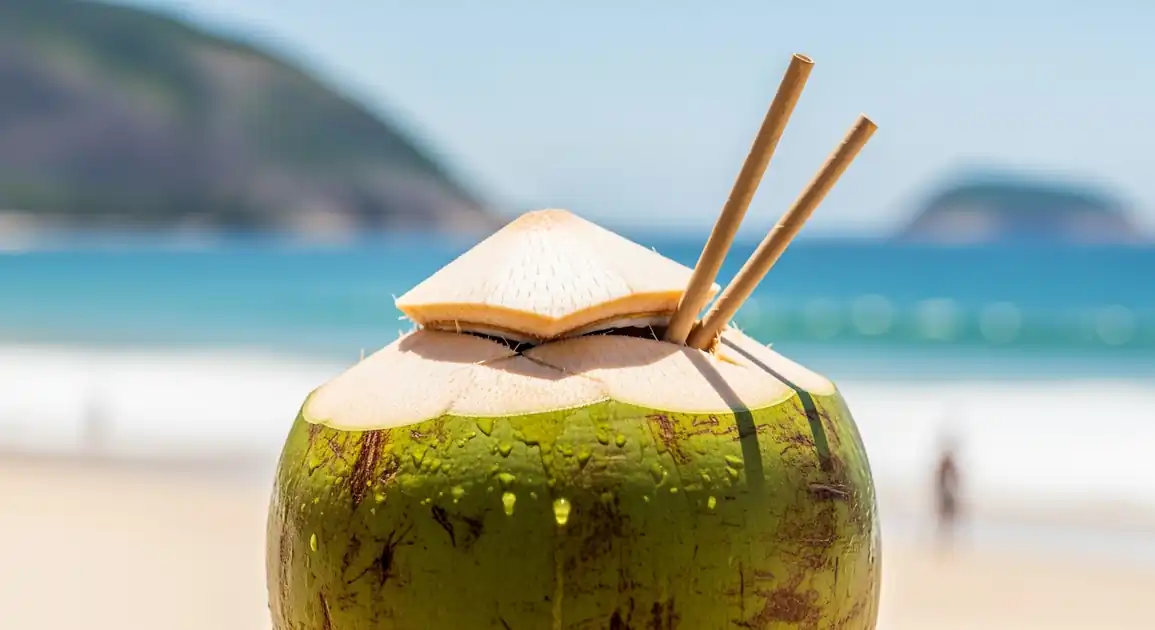Água de Coco (Coconut Water)
Água de Coco

Description
Água de Coco is enjoyed throughout Brazil, but it's particularly prevalent and culturally significant in coastal regions and the tropical North/Northeast. It's a symbol of beach life, health, and natural refreshment available year-round from countless vendors.
Dietary Information
Serving information
Serving style
Most commonly served directly in the chilled green coconut with one or two straws inserted through a hole cut in the top. Also available bottled/carton.
Quick facts
Vendors typically operate during daylight hours, from mid-morning until sunset (e.g., 9 AM - 6 PM), longer hours at busy beach kiosks or nightlife areas.
Safety Tips
What to Look For
-
Freshly opened coconut
Ensures the water inside is sterile and hasn't been contaminated after opening.
-
Chilled coconut ('bem gelada')
Improves taste and helps keep the water refreshing and safer in hot climates.
-
Clean knife/machete used for opening
Reduces the risk of transferring contaminants from the husk surface into the water.
-
Clean, preferably packaged, straws
Avoids contamination from dirty hands or straws left exposed.
-
Vendor with clean hands and cart
General hygiene is a good indicator of safe practices.
What to avoid
-
Pre-opened coconuts
Risk of contamination after opening. Always watch it being opened for you.
-
Coconuts with visible cracks or mold
Indicates potential spoilage or contamination of the water inside.
-
Dirty knife/machete
Can introduce bacteria directly into the coconut water.
-
Unwrapped straws handled with dirty hands
Easy way to transfer germs.
-
Coconut water that tastes sour, fermented, or off
Indicates spoilage; do not drink.
Price information
Price range
Budget tips
- Prices are generally lowest from street vendors or in local markets.
- Beach kiosks in prime tourist spots (e.g., Copacabana south zone) tend to charge the most.
- Prices are per coconut.
Value indicators
- Coconut feels heavy for its size (lots of water).
- Served well-chilled.
- Opened cleanly with a clean knife.
- Fresh, slightly sweet taste.
Where to Find This Dish
Beaches ('Praias')
Iconic setting. Kiosks and mobile vendors are fixtures on almost every popular Brazilian beach.
Copacabana, Ipanema (Rio), Porto da Barra (Salvador), beaches nationwide
All day, especially sunny days
Parks and Squares ('Praças')
Vendors often set up carts in public parks and busy squares.
Lagoa Rodrigo de Freitas (Rio), Campo Grande (Salvador), local parks
Daytime, Weekends
Street Corners
Mobile vendors ('carrinhos') are common on busy city streets.
High foot traffic areas
Daytime
Vendor Tips
- Specify 'bem gelada' (very cold) for the most refreshing experience.
- Have cash in small denominations ready, especially for street vendors.
- Don't forget to ask them to open it for the flesh ('polpa') afterwards if you want it.
How to Order
Regional Variations
-
Straight from the Coconut
(Água de Coco (no coco))
The classic way: served chilled in the green coconut itself with straws.
-
Bottled/Carton Coconut Water
(Água de Coco (de garrafa/caixinha))
Pasteurized coconut water sold in supermarkets. Convenient but often loses some fresh flavor and nutrients.
-
With Coconut Flesh ('Polpa')
(Água de Coco com Polpa)
Enjoying the soft, jelly-like flesh after drinking the water.
-
Sweetened Coconut Water
(Água de Coco Adoçada)
Less common for fresh coconut water, but some vendors or bottled brands might offer versions with added sugar.
-
Coconut Water in Cocktails
(Água de Coco em Coquetéis)
Used as a mixer in alcoholic drinks, like 'Batida de Coco'.
Cultural context
History
Coconut palms are abundant along Brazil's extensive coastline, and consuming coconut water has been a part of local life for centuries, valued for hydration in the tropical climate. It gained massive popularity as a natural health drink and beachside refreshment, becoming deeply integrated into Brazilian culture, particularly in coastal cities like Rio de Janeiro and Salvador. Commercial bottling increased its availability nationwide.
Local significance
Deeply ingrained in Brazilian lifestyle, associated with health, nature, beaches, and relaxation. A symbol of tropical Brazil.
Eating customs
- Drank directly from the coconut using straws.
- Eating the soft pulp afterwards is common.